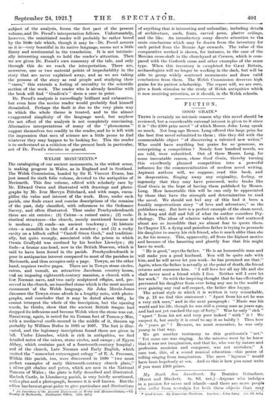WELSH MONUMENTS.* The cataloguing of our ancient monuments, in the
widest sense, is making progress in Wales, as in England and in Scotland. The Welsh Commission, headed by Sir E. Vincent Evans, has just issued its sixth folio volume, devoted to the antiquities of Merioneth. This fine volume, edited with scholarly care by Mr. Edward Owen and illustrated with drawings and photo.
graphs by Mr. Ivor Mervyn Pritchard, and with maps, exem- plifies the value and interest of the work. Here, under each parish, one finds exact and concise descriptions of the remains of the past, duly classified, with references to the Ordnance Survey, and often illustrated. Thus under Penrhyndeudraeth there are six entries : (1) Cairns—a ruined cairn ; (2) eccle- siastical structures—the church, merely mentioned because it is modern ; (3) roads—an ancient trackway ; (4) historic sites—a monolith in the wall of a meadow ; and (5) a rocky cavity on a hillock called " Castell Owen Goch," and tradition- ally, but quite wrongly, associated with the prison in which Owain Gruffydd was confined by his brother Llewelyn ; (6) finds—a bronze axe-head, now in the British Museum, which is said to have been found in the parish. Penrhyndeudraeth is poor in antiquarian interest compared to most of the parishes in Merioneth, and thus occupies only a page. Towyn, on the other hand, requires twelve pages. There are in Towyn stone circles, cairns, and tumuli, an attractive Jacobean country house, and an imposing eighteenth-century mansion, a church with a tine Norman nave, and two early sculptured effigies, and, pre- served in the church, an inscribed stone which is the most ancient monument 'of the Welsh language. Sir John Morris-Jones discusses the Towyn atone afresh in a lengthy note, with photo- graphs, and concludes that it may be dated about 660,; he cannot interpret the whole of the inscription, but the opening words, he thinks, show that the ancient British tongue had dropped its inflexions and become Welsh when the stone was cut. Maentwrog, again, is noted for its Roman fort of Tomen-y-Mur, with a mediaeval castle-mound in the middle of it, thrown up probably by William Rufus in 1095 or 1097. The fort is illus- trated, and the legionary inscriptions found there are given in lull. Under Llanaber, which is rich in antiquities, we fmd letailed notes of the cairns, stone circles, and camps ; of Egyrn Abbey, which contains part of a fourteenth-century hospital ; and of the church, Late Norman and Early English, which excited the " somewhat extravagant eulogy " of E. A. Freeman, Within this parish, too, were discovered in 1890 " two most perfect examples of early thirteenth-century church plate," a silver-gilt chalice and paten, which are now in the National Museum of Wales ; the plate is fully described and illustrated. Harlech Castle, in Liandanwg parish, is very briefly mentioned, witha plan and a photograph, because it is well known. But the editor has been at great pains to give particulars and illustrations
• An Inventory of the Ancient Monuments in Wales and Monmouthshire. VI Comity of Merioneth. Stationers Office. [25s. net.]
of anything that is interesting and unfamiliar, including details of architecture, roofs, fonts, carved pews, plaster ceilings, and the like. An introductory essay directs attention to the main conclusions which may be drawn from the inventory for each period from the Bronze Age onwards. The value of the comparative method is shown, for instance, in the case of the Mercian cross-shaft in the churchyard at Corwen, which is com- pared with the Gosforth cross and other examples of the same type. When this inventory is completed for Gif.at Britain, archaeologists will no longer be working in the dark, but will be able to group widely scattered monuments and draw valid conclusions from them. The Welsh Commission deserves high praise for its patient scholarship. The report will, we are sure, give a fresh stimulus to the study of Welsh antiquities which is now receiving attention, as it should, in the Welsh schools.


































 Previous page
Previous page